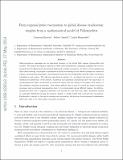From regional pulse vaccination to global disease eradication: insights from a mathematical model of poliomyelitis
Author(s)
Browne, Cameron J.; Smith, Robert J.; Bourouiba, Lydia
DownloadBourouiba_From regional.pdf (698.7Kb)
OPEN_ACCESS_POLICY
Open Access Policy
Creative Commons Attribution-Noncommercial-Share Alike
Terms of use
Metadata
Show full item recordAbstract
Mass-vaccination campaigns are an important strategy in the global fight against poliomyelitis and measles. The large-scale logistics required for these mass immunisation campaigns magnifies the need for research into the effectiveness and optimal deployment of pulse vaccination. In order to better understand this control strategy, we propose a mathematical model accounting for the disease dynamics in connected regions, incorporating seasonality, environmental reservoirs and independent periodic pulse vaccination schedules in each region. The effective reproduction number, R[subscript e], is defined and proved to be a global threshold for persistence of the disease. Analytical and numerical calculations show the importance of synchronising the pulse vaccinations in connected regions and the timing of the pulses with respect to the pathogen circulation seasonality. Our results indicate that it may be crucial for mass-vaccination programs, such as national immunisation days, to be synchronised across different regions. In addition, simulations show that a migration imbalance can increase R[subscript e] and alter how pulse vaccination should be optimally distributed among the patches, similar to results found with constant-rate vaccination. Furthermore, contrary to the case of constant-rate vaccination, the fraction of environmental transmission affects the value of R[subscript e] when pulse vaccination is present.
Date issued
2014-07Department
Massachusetts Institute of Technology. Department of Civil and Environmental Engineering; Massachusetts Institute of Technology. Department of MathematicsJournal
Journal of Mathematical Biology
Publisher
Springer-Verlag
Citation
Browne, Cameron J., Robert J. Smith, and Lydia Bourouiba. “From Regional Pulse Vaccination to Global Disease Eradication: Insights from a Mathematical Model of Poliomyelitis.” J. Math. Biol. (July 30, 2014).
Version: Author's final manuscript
ISSN
0303-6812
1432-1416